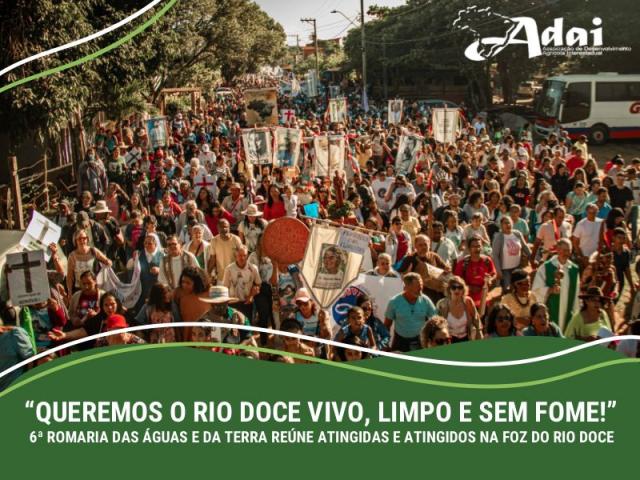“We want the Rio Doce Alive, Clean and Hunger-Free!” 6th Water and Land Pilgrimage brings together those affected at the mouth of the Rio Doce

An act of faith, struggle and resistance marked by denunciation of the countless damages suffered by the Fundão Dam mud in 2015 and the search for reparation.
The sun was still shy after a night of rain on Sunday morning (18), when those affected from Espírito Santo (ES) and Minas Gerais (MG) began to arrive in the town of Regência, on the coast of Linhares (ES), to take part in the 6th Rio Doce Basin Water and Land Pilgrimage. This is the first time that the pilgrimage, organized by the Diocese of Colatina, has been held in the state. The event brought together around 4,000 people, according to the organizers.
The moment in Regencia is also the celebration of a whole sequence of activities, which began with themed seminars in the cities of Baixo Guandu, Colatina and Linhares between May and June. These meetings, which included the participation of those affected, as well as Adai’s technical advisors for those affected, commemorated the dam collapse and once again raised the need for social and environmental regeneration throughout the Rio Doce Basin.
People from many places were welcomed. Maria da Glória Bueckur, who has lived in Regencia for 20 years, expressed her gratitude for the pilgrimage and said that “the town needed a moment like this to bring hope and encouragement to the lives of Regencians”.
After the welcome, the pilgrims left the church of São Benedito, in the town’s central square, in the direction of the beach. Throughout the journey, prayers were said, slogans were spoken and memories were evoked of people who are part of the struggle for full reparations, as well as the martyrs of the cause and the problems that plague those affected. It was a moment of joining forces between those affected, civil society, traditional communities and peoples and the Catholic Church for social justice and a cry for reparations.
With the theme “Rio Doce Basin, our common home”, the pilgrimage strengthens the outcry of those affected who live along the Rio Doce basin, in defense of the “Common Home” and the regeneration of the river. The socio-technological disaster, which hit the Rio Doce, killed 19 people and left a trail of social and environmental destruction along almost 600 km, from Minas Gerais to Espírito Santo. The proportions of this disaster have yet to be fully measured, even almost eight years after the tragedy.
According to João Paulo Izoton, a sociologist who is active in the Movement of People Affected by Dams (Movimento de Atingidos por Barragens – MAB), the decision to hold the pilgrimage by the National Conference of Bishops of Brazil (Conferência Nacional dos Bispos do Brasil – CNBB), the Diocese of Colatina and the Archdiocese of Vitória, is in line with the struggle of those affected. “Water for life, water and energy with sovereignty, distribution of wealth and popular control” is the same subject as the Land and Water Pilgrimage. And the choice of the Rio Doce was the right one, as it is the scene of the biggest crime against our common home that has ever taken place in Brazil, which has contaminated water, a precious commodity that we all depend on. For us, it was a very happy moment to participate with so many people shouting in one voice for respect for our common home and justice for the crimes committed, especially against the Rio Doce and those affected,” she concluded.
The pilgrimage ended with a Mass presided over by the Bishop of Colatina, Monsignor Lauro Sérgio Versiani Barbosa, who made an analogy to the story of Caboclo Bernardo, who saved the men from shipwreck in the sea off Regencia and asked for a lighthouse as a reward. “May our pilgrimage and the topics discussed during its program be a beacon so that other people don’t go through what people living in towns bordering the Rio Doce are suffering,” he emphasized
At , in memory of the people’s struggle, a wooden cross was fixed on the beach, which was carried by those affected throughout the pilgrimage in memory of the people’s struggles. The cruise will receive an explanatory plaque and will be on permanent display.
It is the right of the people affected to be compensated for the damage they suffered as a result of the collapse of the Fundão Dam in 2015. It is the right of Mother Earth, as our common home, to continue to exist and be biodiverse, and the pilgrimage held in this territory marks this right. As was echoed through the streets of the town in the slogans of those affected during the walk: “Water for life, not for death!” and “From the river to the sea, they won’t shut us up!”.
Text and image: Communication Collective of Adai’s Office of the Affected People

